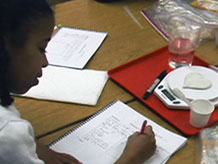What happens to weight and volume when we reshape a ball of clay?
3. Make meaning
Purpose of the discussion
The purpose of the discussion is to construct an evidence-based explanation of what happens to weight and volume when a ball of clay is reshaped. Focus the discussion on the investigation question.
What about conflicting claims? Students should find that the weight and volume remain constant no matter what shape they make with the plastic modeling clay. If a conflicting claim arises in class, i.e., if someone claims that the weight or volume of their plastic modeling clay has indeed changed, lead a discussion of what might account for the finding. Could some of the plastic modeling clay have been lost in the transformation? Could there be a measurement error? Could the counterclaim in fact be correct? The student may wish to repeat the experiment with a new ball of plastic modeling clay to resolve the dispute. In any case, let students know that scientists sometimes do get different results from the same investigation. It's by sharing data that they resolve these differences.
Engage students in the focus question

To engage students, have the investigation materials available and recalling the investigation question. Provide a minute for students to discuss the claim they would make and the evidence that supports it.
What happens to weight and volume when we reshape a ball of plastic modeling clay?
- What claims can you make? What is your evidence?
- Does this make sense to you? Why do you think the weight and volume stay the same when you change the shape?
Listen for the argument that weight and volume do not change because no material has been added or removed; the material has just been rearranged. If someone says that the new shape "looks" bigger or smaller, acknowledge that this may be so, ask the student to describe what the data say, and revisit the idea that we can’t always rely on our senses for measuring weight or volume.
Make a connection to the students' everyday life.
- Can you think of an example of crushing something and having the volume change? How would you explain this?
- The volume of the space inside an empty soda can will change when the can is crushed, but the volume and weight of the aluminum will remain the same.
- The bulk volume of a box of cornflakes will change if the contents settle. As with the soda can, it’s the volume of air that is reduced; the weight and volume of the cornflakes themselves remains the same.
Sometimes Volume Seems to Change: Solids and liquids are virtually incompressible. Squeezing them will not change their volumes or weights. Gases are a different story. Gases are compressible because their molecules are much more spread apart than those of solids or liquids, but this is not a topic you need to raise with students at this point.
Summarize the discussion
Use the same language that the students used to explain that weight and volume do not change because no material has been added or removed, only rearranged.
As you recap the investigation, check for understanding that when the shape of a malleable object changes, its weight and volume stay the same.



